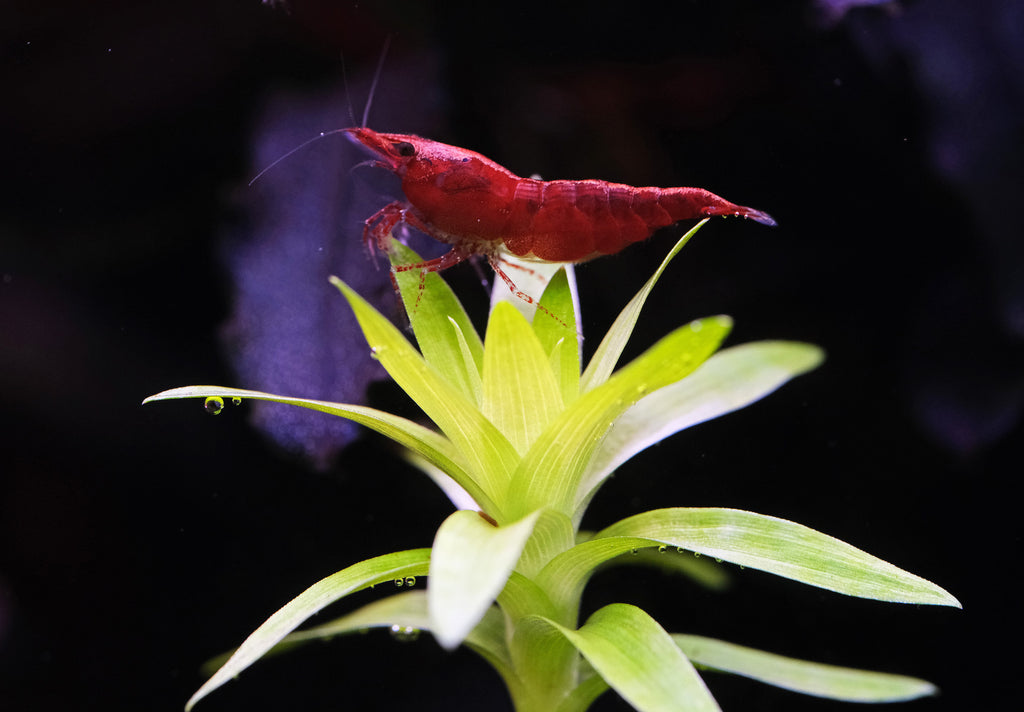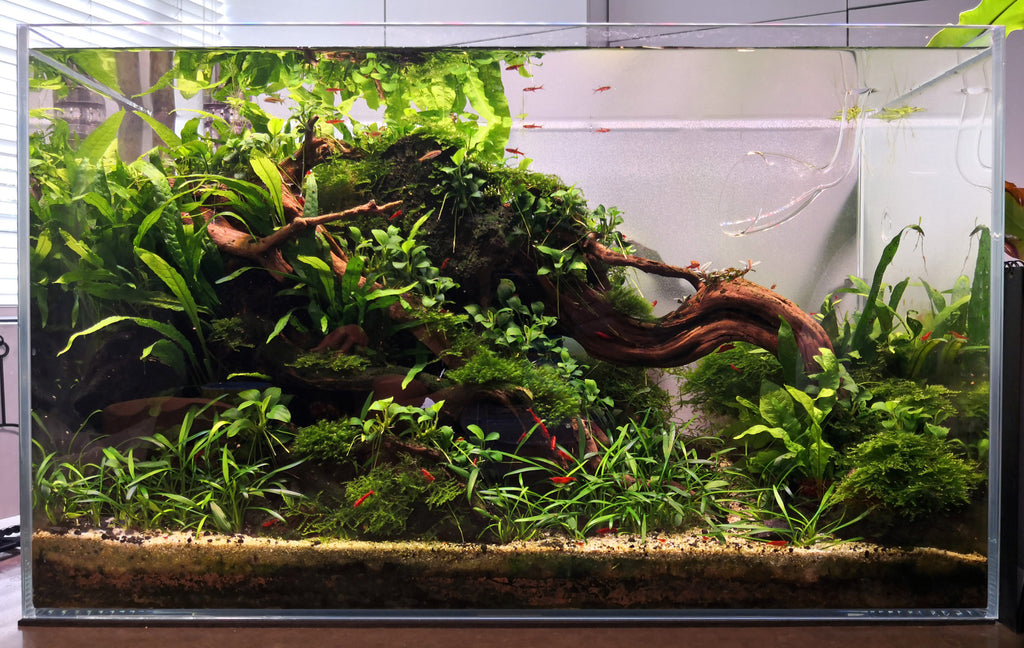Your Cart is Empty
Menu

Keeping dwarf shrimp in planted tanks
February 10, 2025 7 min read

Introduction
There are many species of dwarf shrimp on the market today, with a dizzying number of different colour variations and patterns. Some species have become very popular in the hobby, such as the ubiquitous and easy to care for Cherry Shrimp "Neocaridina davidi", while there are other species with more specific requirements, such as Crystal Red Shrimp "Caridina Cantonensis" and Sulawesi Shrimp.
These shrimp are non-aggressive to other fish and their striking colours make them stand out in planted tanks. They also provide a visual treat as they forage for algae and detritus on plants and hardscape. While it may be difficult to observe these shrimp in the wild due to their small size, the aquarium provides the perfect setting to study them up close.

Dwarf shrimp are scavengers that feed on organic detritus, algae and micro-organisms. However, if you have a dead fish or uneaten fish food in the tank, they will also gather it up and try to consume it. In planted tanks, they perform the useful functions of breaking down organic waste and dead leaves and consuming algae.
Pros
-
Aesthetic and colorful
-
Consumes algae and breaks down organic waste
-
Non-aggressive towards other livestock
-
Breeds easily given suitable tank conditions
-
Matches planted environment very well
Cons
-
Sensitive to ammonia, water quality and parameters
-
Prey to larger fish, especially shrimp fry

Tank environment
There are a few aquarium qualities that all shrimp prefer. Shrimp are small and delicate creatures. They prefer well-circulated tanks with good water quality, and a mature tank environment with good filtration and biological stability is most important. Different species will also have specific requirements when it comes to water parameters. It is also good to have surfaces such as moss or rocks where biofilm has developed to provide grazing areas for shrimp. Shrimp are often at the bottom of the natural food chain and are prey for larger fish and other animals. This is especially true of baby shrimp, and providing them with adequate hiding places in the tank will greatly improve their survival rate in tanks where fish are also kept.

In terms of needing an environment with good water quality and biological stability, shrimp actually have a lot in common with what is optimal in a well run planted tank. We want a tank with adequate filtration and circulation (shrimp like well oxygenated water like any other animal). A well-circulated tank where plants have been growing for some time and where there are no abrupt changes on a regular basis is ideal. This also means that introducing shrimp into a freshly planted tank on day 1 is a terrible idea. While shops may push this in an attempt to sell entire planted systems in a single day, it is much better to allow the tank's biological system and plants to mature for a few weeks before introducing sensitive animals such as shrimp. A planted aquarium goes through many significant changes when it is first set up; if aquasoil is used, the soil biology has to change from a dry to a submerged state, the plants need time to adapt and grow in, and there may be significant pruning/replanting of plants. Algae may spawn and the hobbyist may choose to make larger water changes on a regular basis for the first few weeks of a set-up. The microbes in the soil and filter need time to develop. All of these instabilities will affect the water quality of the aquarium in the first few weeks of a newly planted aquarium.
Key points:
- Maintain good water quality by having adequate filtration and circulation, matured tank environment.
- Have adequate hiding and grazing spots. A well planted tank should have no shortage of either.
- Add shrimp to a matured setup, not on day 1.

Water parameters
Different shrimp species have different water parameter requirements. Neocaridina species tend to be more robust and can be kept in a wide range of water parameters from very soft to harder water. Caridina species tend to prefer softer, low KH water. Sulawesi shrimp prefer more alkaline water and higher temperatures. As a very general guide, cheaper shrimp are easier to keep and more adaptable, while more expensive shrimp tend to have more specific requirements and are harder to breed (hence the higher market price due to reduced supply vs. demand). Before buying a particular shrimp, check the requirements for that species.
A temperature between 21°C and 26°C is suitable for almost all dwarf shrimp species. Higher temperatures result in a faster life cycle, which means faster growth and more reproduction, but also a shorter life span. Sulawesi shrimp prefer higher temperatures; 26°C to 30°C.
As with plants and fish, it is much easier to keep shrimp that adapt to your tap water parameters.
These are some general guidelines for each genus:
Neocaridina davidi shrimp (Cherry/Fire red/Bloody mary/Chocolate/Yellow):
pH: 5-8
GH: 3-15
KH: 0-12
TDS 50-400
Caridina cantonensis shrimp (Crystal red, Crystal black):
pH: 5.5-7.5
GH: 4-8
KH: 0-4
TDS 50-300
To read more on what does pH, GH, KH and TDS mean, head to the water parameters page.

Although the ranges given are enormous, it does not mean that just because your tank parameters are within the range, you can just buy the shrimp and drop them into the tank. Depending on how a particular batch of shrimp is bred, they will be more suited to those water parameters.
Successfully acclimatising shrimp to your tank parameters is an important step in ensuring their survival. It is therefore best to buy shrimp from breeders that have similar water parameters to your tank. If this is not possible, get shrimp from a source where you can easily adjust your water parameters to match, e.g. a Bloody Mary shrimp that has been bred in pH 5.5, 1dKH water will find it difficult to acclimatise to a pH 8, 12dKH tank. However, if you can find a source that has bred the Bloody Mary shrimp at pH 7.5, 8dKH, then the chances of them successfully acclimatising to your pH 8, 12dKH tank parameters will be much higher.
More robust, easier to keep varieties such as Cherry Shrimp will acclimatise more easily to parameters different from those in which they were bred, while more sensitive varieties such as Crystal Red Shrimp are best introduced to water similar to that in which they were bred.

CO2 injection
CO2 injection causes the pH of the water to drop, often by as much as 1 full point. This will not affect the shrimp as long as the underlying GH and KH levels do not change. (CO2 injection alone does not change GH/KH levels). Although often touted as an important value, pH fluctuations alone, with no change in carbonate hardness, have little effect on the animals. To read more on pH fluctuations due to CO2, click here.

This tank is close to 0 KH due to the Aquasoil + very soft tap water. The pH drops about 1.4 points daily from 6.5 to 5.1 during the CO2 injection. Bloody Mary shrimp still breed like rabbits in this environment. Occasional feeding with shrimp food will speed up reproduction rates.
While hardier shrimp species (such as the common Neocaridina and Caridina) can breed in CO2-injected tanks, delicate species (generally higher priced species that have very specific requirements) may breed less readily when CO2 levels are cranked up. Sensitive species may also be more stressed by frequent large water changes and other disturbances to the tank environment. If you are worried about stressing sensitive shrimp breeds and want to concentrate on breeding shrimp rather than growing a wide variety of plants, you may consider setting up a low-tech tank with simpler, lower maintenance plants. Such tanks are very easy to maintain. Slower growing plants due to the lack of CO2 injection means less pruning and replanting and less disturbance to the tank environment.
 A low-tech tank with mostly moss and simple plants is almost maintenance free. This tank has a 30% water change every few weeks, while the mosses are only pruned once every few months. Although the tank is a little small for fish, the shrimp thrive in this planted aquascape.
A low-tech tank with mostly moss and simple plants is almost maintenance free. This tank has a 30% water change every few weeks, while the mosses are only pruned once every few months. Although the tank is a little small for fish, the shrimp thrive in this planted aquascape.
Fertilization
The most common question asked about fertiliser is, "Will the copper in the fertiliser harm my shrimp? The levels of copper in commercial fertilizers are too low to affect aquarium animals. DIY mixes that are overdosed with poor quality trace elements can be a problem, but even then it takes a significant overdose. Most liquid fertilizers do not affect water parameters significantly enough to cause problems, even with sensitive shrimp breeds.
Water changes
Large water changes (e.g. over 90% of the tank volume) in themselves will not affect the shrimp or the stability of the tank if the water used to replenish the tank has the same parameters as the tank water. However, in reality there may be significant differences in water temperature or other parameters. Also, draining the tank to very low levels can in itself stress the animals.
Hardier species such as cherry shrimp or common CRS can cope with large water changes without problems. However, for more delicate species you may wish to moderate your water change rate to, say, 30% every 2 weeks. Low-tech, non CO2-injected tanks, where growth rates and maintenance requirements are lower, are ideal for breeding finicky shrimp species.
Conclusions
An optimised planted tank has many qualities that shrimp also prefer. The core quality that both shrimp and plants appreciate is a biologically stable tank with good water quality over the long term. The same things that trigger algae - high fluctuations, ammonia, non-cycled tanks - are the same things that harm shrimp. The fears about fertilisers and carbon dioxide affecting shrimp are often exaggerated by inexperienced people who lose shrimp due to a huge range of other bad practices than the 2 factors they blame. Delicate shrimp species have a significant mortality rate when handled by less than expert hands - with no correlation to fertilisation or CO2 use.
Evidence that skilled planted tank growers can produce a wide variety of shrimp species in their well-fertilised, CO2-injected setups is becoming increasingly common. However, it requires mastery of both aspects; shrimp husbandry and plant horticulture skills.
unlock your true potential
Grow anything, defeat algae, create amazing aquascapes
























